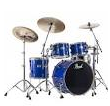
The standard drum kit consists of 2 rack toms, 1 floor tom, 1 base drum and 1 snare drum. The bass drum is the big drum in the middle of the floor. It is played by a pedal operated by the right foot. It provides the basic beat of the music, it has the deepest tone of all the drums in the kit. The snare drum is mounted on a stand, played with drumsticks, , brushes or at times with rute sticks . It is important as it provides the strongest regulator accents and is the backbone for many frills. It produces a distinctive snappy sound and is the center of the drum kit. It has wires underneath it called “snares” which are made of nylon wire. The snare sits between your legs.
Toms : Two or more of these drums provide the bulk of most drum solos and frills. They are drums without snares and can be played with the brushes or sticks as the music style requires. The bigger the tom, the deeper the sound will be. The floor tom is a very large tom tom and usually has legs on it.
Hi-hat : It sits to the left of the snare drum and looks like a hat. It is opened and closed with the left foot pedal and played with sticks. The hi-hat helps to keep the finer rhythm within the music played.
Cymbals : These come in different thicknesses and weights. The crash cymbals usually provide the major changes of mood and effects within the piece of music. They often are the strongest accent markers for climaxes and crescendos and are used to stress prominence on certain parts of the music. To provide a fuller sound and for musical effect, a crash cymbal is often accompanied simultaneously by a strong kick on the bass drum pedal. Ride cymbals are usually the thickest and biggest cymbals in the drum set. They vary from 18 inches to 24 inches in diameter.
The drum kit can be divided into 4 parts
The Shells : Bass drum and Toms
Extensions : Tambourines, chimes, cowbells including other instruments which are not part of the
standard kit.
The breakables : Various cymbals, snare drum, sticks, stool and sometimes the bass drum pedal.
Hardware : Drum stands, cymbal stands, pedals, floor tom legs, drum key.
Drumsticks : The most common drum sticks are made of wood, comes in a variety of tip designs and
weights. The sticks are traditionally expressed as a letter following the number. Usually, the higher numbers, mostly odd numbers indicate that they are lighter sticks. Apart from wood, other materials used for manufacturing sticks include acrylic, aluminium and graphite. Nylon drum brushes and rutes which are often used as sticks.
Essential things to have
1. Carpets : The carpet helps to reduce reverberation, prevents damage to the flooring, prevents the
hi-hat stand and the bass drum from moving away on a slippery surface.
2. Metronomes : This will assist the drummer to develop a good sense of rhythm
3. Tuning equipment : A drum key is essential for tuning the drums as well as adjusting certain drum
hardware.
4. Practice equipment : A practice pad which is held on the leg, on the lap or even mounted on a stand
is used when you need to practice in an environment where noise is an issue.
Electronic Drum Kit
The electronic drum kit is compact, portable and can fit into small spaces or rooms. It can be folded up and packed away after practicing. The greatest benefit is the ability to practice with the earphones, thus reducing noise, ideal for environments where noise issues need to be avoided. This drum kit gives the drummer the ability to play and record his track while being able to do editing of instruments or notes. It is perfect for recording and can be plugged directly into the recording equipment. Many electronic drums have tools like metronome to check how in time you are. Multiple sounds allow the drummer to experiment different playing styles. He is able to switch from genre to genre thus having fun while learning. Since he is not hitting real drum rims and sharp cymbal edges, the drum sticks tend to last longer. Another benefit is that he need not worry about tuning electronic drums as they
do not need tuning. However, the disadvantage is that the electronic drums do not sound and feel the same as an acoustic drum set.
Acoustic Drum Kit
A real acoustic drum set has great dynamics and the drummer is able to play with great touch and feel.
The drummer is able to perform drum rolls, cymbal swells, hi-hat techniques and cross stick to a more
realistic level compared with the electronic drums. However, these drums are very loud and one would need to consider very carefully before purchasing if noise is an issue in the environment that he is living. Acoustic drums need to be tuned and drum heads need to be replaced occasionally, depending
on how hard and often the drummer plays. These drums are bigger and heavier, so more space is needed. More time is also needed to set up or breakdown an acoustic drum kit.
Call us at 012-2408162 / 03- 40221027 / 40211072 for more information.